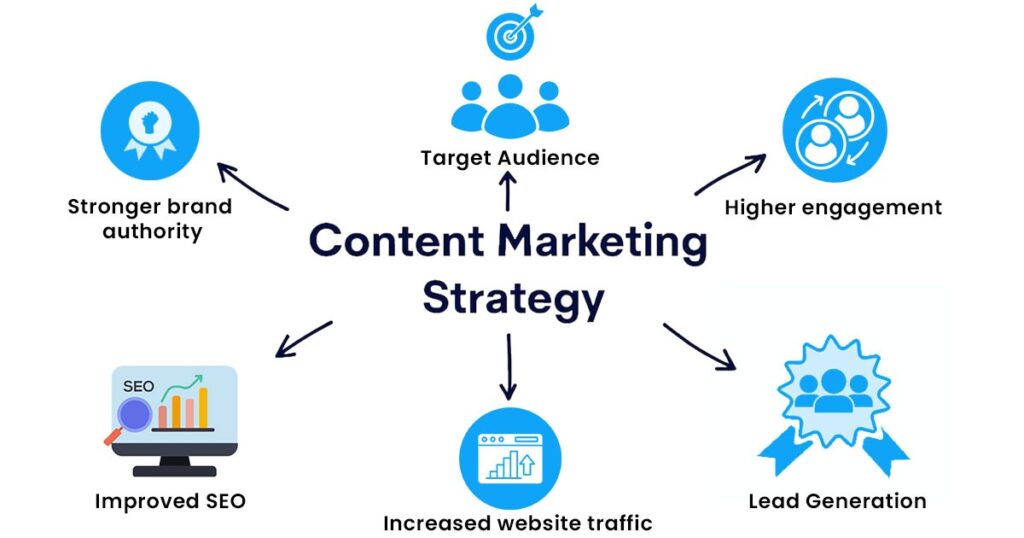An effective content marketing strategy is essential for any business that wants to grow online. With more brands competing for attention, producing random content is no longer enough. A clear, structured strategy supported by professional content marketing services helps you reach the right audience, deliver value consistently, and achieve measurable business results. These services include content planning, creation, SEO optimization, distribution, and performance tracking to ensure every piece of content supports your business goals.
In this step-by-step guide, you’ll learn how to plan, create, and scale a content marketing strategy that drives traffic, builds trust, and increases conversions.
What Is a Content Marketing Strategy?
A content marketing strategy is a long-term plan for creating and distributing valuable, relevant content to attract and retain a clearly defined audience. It is designed to guide potential customers through their buyer’s journey—from awareness to decision—by solving problems and answering questions at each stage.
This strategy involves more than just blog posts. It includes all types of content: videos, emails, case studies, infographics, podcasts, social media posts, and more. The key is consistency and relevance to your target audience.
Why Content Marketing Matters for Business Growth
Content marketing is one of the most effective and sustainable ways to build brand awareness, generate leads, and improve customer loyalty.
Key benefits of content marketing include:
- Increased website traffic through organic search visibility
- Higher engagement by providing useful, shareable information
- Lead generation through downloadable resources and email capture
- Stronger brand authority by showcasing your expertise
- Improved SEO via keyword-rich, high-quality content
Businesses that prioritize content marketing see 67% more leads than those that don’t, and they spend less on paid advertising in the long run.
Step 1: Define Your Goals and KPIs
Every successful strategy starts with clear goals. Before creating any content, define what success looks like and how you’ll measure it.
Common content marketing goals:
- Drive organic traffic to the website
- Increase social media engagement
- Build a targeted email list
- Generate qualified leads
- Improve brand reputation and trust
Use Key Performance Indicators (KPIs) like pageviews, bounce rate, conversion rate, and average session duration to track your progress and optimize over time.
Step 2: Understand Your Target Audience
Knowing who you’re speaking to is crucial. Your content must align with your audience’s interests, challenges, and buying behaviors.
Create detailed audience personas by identifying:
- Demographics (age, location, job role)
- Goals and pain points
- Preferred content formats (blogs, videos, podcasts)
- Where they spend time online (search, YouTube, LinkedIn, etc.)
- How they consume information and make decisions
This information helps you craft messages that resonate and convert, rather than generic content that gets ignored.
Step 3: Conduct Keyword and Topic Research
To reach your audience organically, you need to align your content with the terms they’re actively searching for. This is where keyword research comes in.
How to conduct content-focused keyword research:
- Use tools like Ahrefs, SEMrush, or Google Keyword Planner
- Identify keywords with high volume and low competition
- Focus on long-tail keywords for niche topics
- Group keywords into themes or topic clusters
- Monitor seasonal and trending topics in your industry
Effective keyword planning ensures your content is both searchable and strategically valuable to your audience.
Step 4: Plan a Content Calendar
A content calendar helps you stay organized, consistent, and strategic. Instead of publishing random posts, you’ll create a balanced mix of content types tied to business goals.
What to include in your content calendar:
- Publish dates and deadlines
- Topics and titles
- Target keywords and personas
- Assigned writers or designers
- Distribution channels (email, blog, social media)
Plan content at least one month in advance, and leave room for trending topics or industry news.
Step 5: Create High-Quality, Purpose-Driven Content
Creating content is about more than writing words—it’s about providing value. Your content should educate, inspire, or entertain while subtly guiding the reader to take action.
Best practices for content creation:
- Start with a clear headline and hook
- Break up content with subheadings and visuals
- Incorporate data, case studies, and expert quotes
- Include clear CTAs (calls to action)
- Ensure your tone matches your brand voice
High-quality content builds trust. Avoid fluff and focus on content that delivers insights your competitors are missing.
Step 6: Distribute and Promote Your Content
Once your content is published, don’t just hope it gets seen—promote it intentionally across multiple platforms to extend its reach.
Top content distribution channels:
- Email newsletters
- Social media platforms (LinkedIn, Twitter, Facebook)
- Influencer collaborations and guest posting
- Paid promotions (Google Ads, LinkedIn Ads)
- SEO for long-term visibility in search engines
Consider repurposing your content into multiple formats—like turning a blog into a podcast episode or infographic—to maximize its value.
Step 7: Measure Performance and Optimize
To continuously improve your content marketing strategy, track what’s working and adjust accordingly. Regularly review your performance using analytics tools.
Key metrics to monitor:
- Traffic sources and trends
- Engagement rates (time on page, scroll depth)
- Lead conversions and form submissions
- Keyword rankings and SEO visibility
- Social shares and backlink growth
Use these insights to update underperforming content, double down on high-converting topics, and improve your ROI over time.
Final Thoughts: Let Us Help You Build a Winning Strategy
Content marketing is a powerful tool but only when done strategically. A well-crafted content marketing strategy can help you build authority, generate consistent leads, and fuel long-term growth. From planning and creation to distribution and analytics, each piece plays a vital role in your success.Want to attract more traffic and leads through expert content? The Maddex is a digital marketing agency that specializes in content strategy, SEO, and growth-focused campaigns tailored to your goals. Contact us today to build a strategy that works smarter, not harder.



